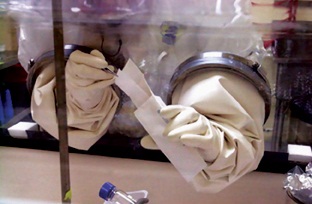Bioterrorism is the deliberate release of viruses, bacteria, toxins, or other agents to cause illness or death in people, animals, or plants. According to experts, the threat of global bioterrorism is increasing. In October 2001, bioterrorism became a reality when letters containing powdered
anthrax were sent through the U.S. Postal Service. The attack caused 22 cases of illness, 5 of which resulted in death, and widespread fear. In response, under the auspices of the U.S. Department of Health and Human Services (HHS), work began on sophisticated biosurveillance systems, which are currently being updated to include an automated detection system for aerosolized agents. In fact, biosurveillance has become an international issue, and countries worldwide, including those in the developing world, are working to improve their systems.
The skills and equipment for making a biological weapon are widely known because they are the same as those required for cutting-edge work in medicine, agriculture, and other fields.
Biological agents are in some ways the perfect weapons of terror. They can be spread through the air, water, or food. Terrorists may choose these agents because they can be extremely difficult to detect and do not cause illness for several hours to several days after exposure, meaning that public health officials may not notice the attack until it is too late. Deadly
pathogens are highly accessible. With the exception of
smallpox, they all occur naturally in the wild—in soil, air, water, and animals. And the skills and equipment for making a biological weapon are widely known because they are the same as those required for cutting-edge work in medicine, agriculture, and other fields. In addition, there is growing concern about the intentional development of pathogens with pandemic potential that could be used by adversaries to inflict widespread harm.
High-priority organisms or toxins that pose the greatest risk to national security are known as Category A agents, according to the National Institute of Allergy and Infectious Diseases (
NIAID). These deadly pathogens could be readily spread in the environment or transmitted from person to person, triggering public panic and requiring special public health precautions.
Many public health officials believe that anthrax is one of the bioweapons of greatest concern—although in the case of the 2001 anthrax mailings in the United States there was less
morbidity and
mortality than many feared would occur. The infection is caused by
Bacillus anthracis, a bacterium that forms spores. Anthrax does not spread from person to person but rather by hard-coated bacterial spores that spring to life under the right conditions. Anthrax can cause
skin lesions and gastrointestinal disease. Inhalation anthrax is the rarest form of the infection and may be the most difficult to treat.

An investigator carefully examines one of the letters tainted with anthrax following the 2001 attack in the United States. (www.fbi.gov)
Another disease of concern is smallpox, a serious, contagious, and sometimes fatal infection. Smallpox was officially declared eradicated from the globe in 1980, after an 11-year World Health Organization (
WHO) vaccination campaign—the first human disease to be eliminated as a naturally spread
contagion. Once the disease was gone, routine vaccination of the general public ceased. Today, the virus remains only in laboratory stockpiles. But in the aftermath of the events of September and October 2001, concern has grown that the smallpox virus might be used as an agent of bioterrorism. These concerns were further heightened by the 2014 discovery of forgotten vials of smallpox, as well as the virus that causes
dengue and the bacteria behind spotted fever, in the basement of the National Institutes of Health (NIH). This finding pointed to lapses in biosafety, which can add challenges to biosecurity efforts.
Another threat—the
botulinum toxin—is the most lethal compound known. This nerve toxin is produced by the bacterium
Clostridium botulinum. Researchers estimate that as little as a gram of aerosolized toxin could kill more than 1.5 million people.
NIAID and the Biomedical Advanced Research and Development Authority (BARDA) are developing tools to detect and counter the effects of a bioterrorist attack, including vaccines to immunize the public against diseases caused by bioterrorism agents; diagnostic tests to help first responders and other medical personnel rapidly detect exposure and provide treatment; and therapies to help patients exposed to bioterrorism agents regain their health.
The Public Health Emergency Medical Countermeasures Enterprise (an interagency effort run by HHS) coordinates federal efforts to confront chemical, biological, radiological, and nuclear threats as well as to enhance emerging infectious disease preparedness from a medical countermeasures perspective. Among the agency’s latest priorities are
Ebola preparedness and response, a focus on emerging diseases such as the Middle East respiratory syndrome coronavirus (MERS-CoV), and a national strategy for combating antibiotic-resistant bacteria. A 2015 report produced by the Institute of Medicine echoes these priorities and points to the need for broader stakeholder engagement, increased investment, and greater collaboration between the public and private sectors.

